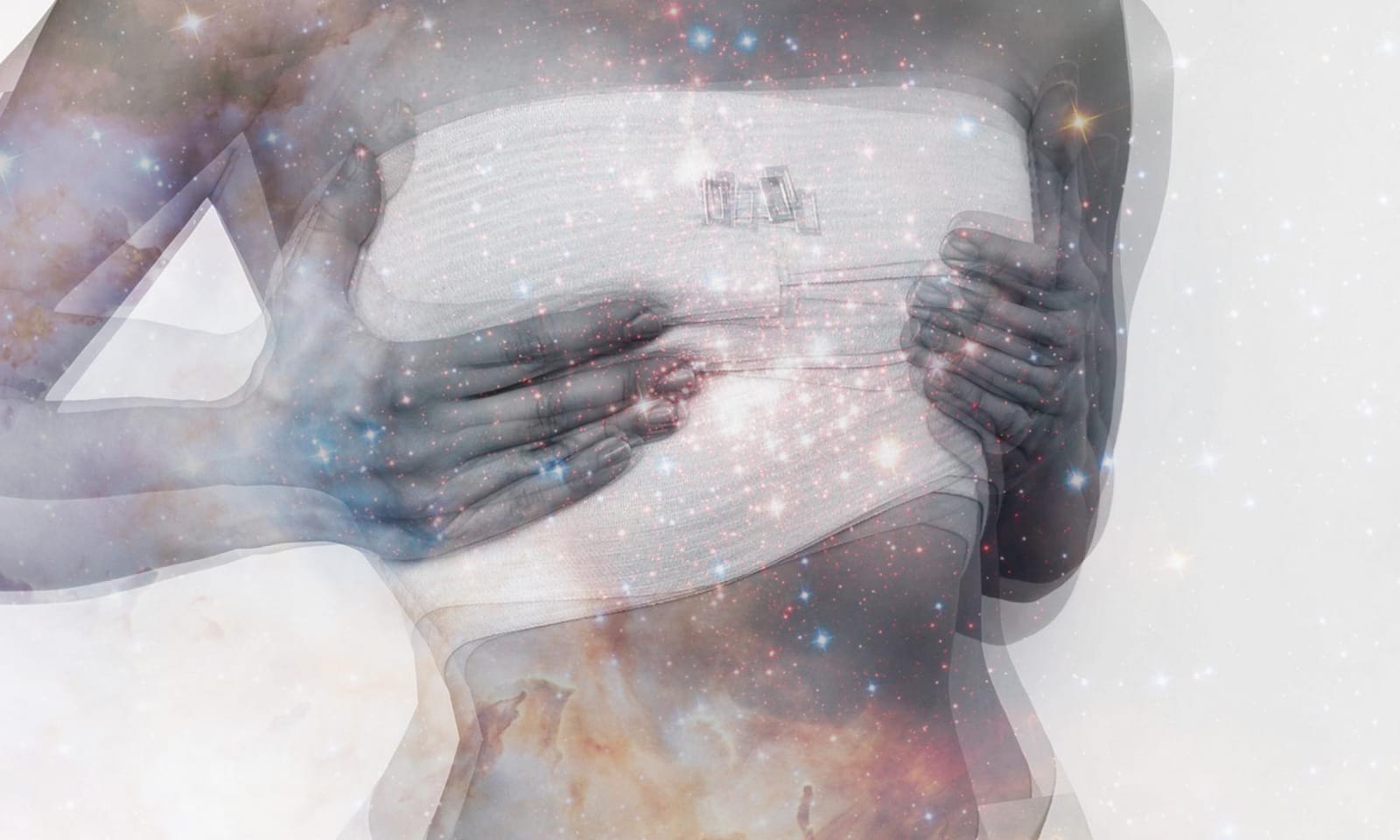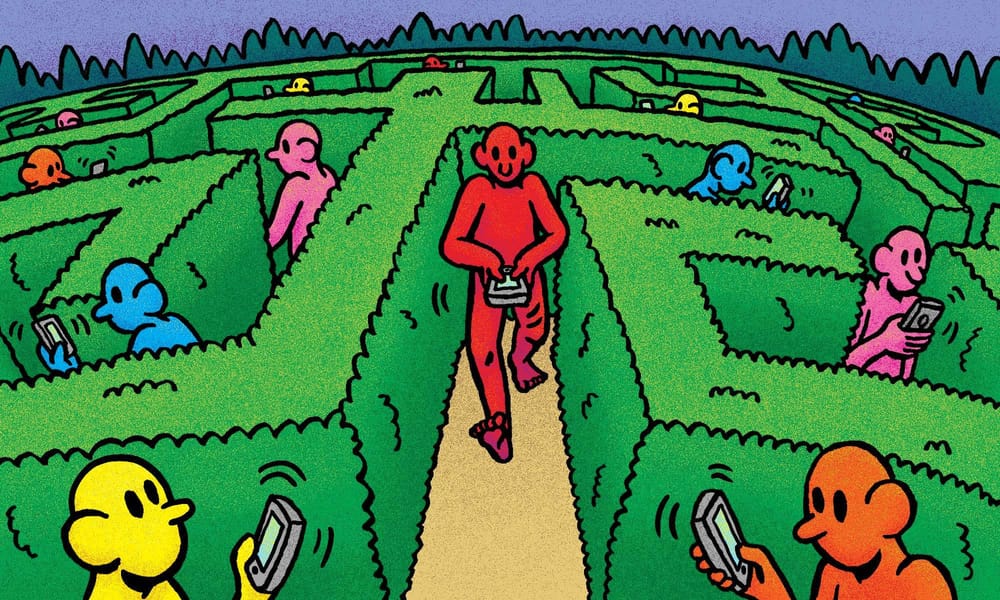This story begins with a roll of binding tape.
After many hours spent stewing away at my desk, anxiously scribbling down any and all thoughts that struck me as carrying the slightest promise for a master’s essay topic, I admitted defeat. I shifted my attention away from my laptop, aware that my friends were due to arrive soon for dinner, only to be confronted by just how messy my desk had become over the course of the working day. It was cluttered with dirty plates, stray clumps of tobacco, and binding tape.
The remnants of unused tape were a visual reminder of the binding tape that was stuck to my chest—a presence that I had largely forgotten amidst my efforts to think and write. Access to this object had become a prerequisite for my ability to be comfortable at all, let alone think or write. At the same time, it is an object about which I feel profoundly ambivalent, since I don’t remember ever struggling to feel comfortable in this way before I started using binding tape to flatten my chest.
How is it that I have ended up here, living as a transgender man whose dysphoria used to be so crippling that, until undergoing a double mastectomy 23 days ago, he couldn’t leave the house without binding his chest? How could my chest, once a relatively background concern in my everyday life, have become such a constant preoccupation? If someone had warned me of this three years ago, back when I was still a bra-wearing girl (of sorts), I would have shot them a very incredulous look.
As far as gender journeys go, this was not where I was supposed to arrive. Quite the opposite, in fact. Mainstream trans-affirmative narratives justify gender transition on the humanitarian grounds that it alleviates gender dysphoria (feelings of discomfort associated with one’s gender assigned at birth). Through transition, we are told, trans folk can wave goodbye to gender dysphoria and even ascend to the heavenly realm of gender joy—a place replete with rainbows in abundance and Starbucks coffee cups with our chosen names written on them. In other words, dysphoria is supposed to precede—indeed, compel—transition; transition is supposed to cure, or at the very least reduce dysphoria.
I clearly missed the memo for, curious as it may seem, I simply didn’t experience what I now register as chest dysphoria before I spent an extortionate amount of money on shipping binding tape from the United States, watched tens of thousands of videos about how best to apply it, and finally, after a lot of frustration, looked in the mirror to see a flatter chest. In that moment, I experienced what is known in trans common parlance as gender euphoria—the feeling of rightness or joy in one’s gender. When I eventually removed the binding tape, however, I felt more ill at ease and unhappy with my chest than ever before. The sensationalist headline might read: “I started binding, and I became dysphoric”.
If trans Redditors and Quorans are to be believed, I’m not alone. In an article for Slate Magazine, social psychologist Devon Price coined the term ‘Dysphoria Paradox’ to capture the experience of feeling more dysphoric, or perhaps dysphoric for the first time, as one takes steps to transition. Price’s answer to the paradox is that rather than transition being capable of generating hitherto non-existent feelings of discomfort, transition can instead only force a reckoning with what has been suppressed. Such a reckoning, Price posits, creates the illusion that one’s dysphoria has materialised out of thin air, when in reality it has just been brought into the light.
Importantly, Price is writing in the shadow of physician-scientist Lisa Littman’s controversial pseudo-diagnostic concept of rapid-onset gender dysphoria (ROGD) which is part of a broader moral panic about an alleged epidemic of previously un-gender-troubled children developing dysphoria as a result of ‘social contagion’. Advocates of this theory insist that kids are being peer-pressured into hating their bodies, as if dysphoric transness is some kind of fad, like getting one too many cartilage piercings or developing a parasocial relationship with Taylor Swift—albeit with far more dangerous consequences.
This idea has been debunked in a statement by the Coalition for the Advancement & Application of Psychological Science (CAAPS), which dismissed ROGD on the basis of there being “no evidence that ROGD aligns with the lived experiences of transgender children and adolescents.”
Price’s own rebuttal of the debunked theory of ROGD relies on a logic that aligns with that of the ‘Born This Way’ gay rights mantra. If gender dysphoria can’t be acquired, only grappled with, then it is a contained phenomenon—by definition not catching, and certainly not a fad. If you have it, you have it, and it will make itself felt eventually; if you don’t, you don’t, and there’s no need to worry about you or your children being infected.
This inference—that one can’t be made dysphoric, whether by one’s peers or indeed by binding tape—certainly quashes the idea that impressionable youngsters are being ‘transed’ on the Internet. In contrast, my sensationalist headline “I started binding, and I became dysphoric” risks stoking the flames of trans-antagonism. By acknowledging that transition can sometimes make us feel bad, my story could be weaponised as evidence that gender transition is an inherently pathological endeavour. It plays directly into the hands of, for example, the anti-trans pressure group Transgender Trend’s description of chest binding as something which should be placed “within the category of self-harm”.
And for those who would rather no trans people existed at all, the possibility of becoming dysphoric implies the possibility of being converted out of such feelings—or indeed, being prevented from developing them at all.
It’s not particularly surprising that my transition experience sets me in opposition to anti-trans theorists. More surprising, my headline finds no support in mainstream trans-affirmative narratives, either; reliant as they are on a simple pipeline from gender dysphoria to gender euphoria.
As the trans scholar Cameron Awkward-Rich has pointed out, such trans-affirmative narratives have responded to the pathologisation of transness by trying to remove debility from the trans equation entirely. Trans-affirming narratives respond to the anti-trans malice with an equally pure positivity. For example, in 2014 transgender man and activist Gavin Grimm sued his local school board for forcing him to use female bathrooms. He explained in a Washington Post op-ed, “We are not perverse. We are not broken. We are not sick. We are not freaks.”
Where can you turn, then, if you are perverse, broken, sick or freakish? By conceding the undesirability of dysphoria and other ‘bad’ trans feelings, we wind up fuelling the ableist rationale that the debility associated with dysphoria (such as my being unable to leave the house) is a blight on life, something to be wished away—and certainly something never to be wished for one’s children.
The stories we tell about dysphoria matter—that much is clear. Of course, I don’t dispute that the story told by proponents of ROGD is scientifically dubious and grossly trans-antagonistic. I certainly wasn’t made dysphoric in the way that trans-antagonistic commentators imagine. I wasn’t manipulated by a shadowy cabal of Reddit-using trans elders eager to increase their numbers, or because a university friend started using they/them pronouns.
But by understanding dysphoria in clinical terms as an individual disposition rather than, say, a political affect and force, we court trans-antagonistic fears of a dysphoric trans planet. I’m riffing on the queer theorist Michael Warner’s dream of a queer planet and his 1991 observation that despite great gains in LGBTQ+ rights, it remains almost unthinkable to understand the emergence of more queers as a desirable outcome for the world. We might succeed in placating those hostile to trans existence by reassuring them that dysphoric transness can’t and won’t spread, but in doing so, we concede the undesirability of transness and resign ourselves to a liberal identity politics that entirely gives up on the project of building new worlds.
This point is nothing new. In their gloriously risque research article entitled “The Transgender Craze Seducing Our [Sons]”; or, All the Trans Guys Are Just Dating Each Other, Cassius Adair and Aren Aizura embrace the trope of contagious gendering in relation to trans erotics. Taking the idiom of seduction from trans-antagonistic commentators, they argue that transness may indeed spread through sexual desire. They tell an anti-assimilationist story about trans becoming, in which transness isn’t a fixed trait but instead a matter of who, and what, we come into contact with.
But what happens if we cease to understand dysphoria as a linear trajectory of progress always oriented in the direction of healing? Staying with Adair and Aizura’s idea of contagion, what happens when we acknowledge that becoming trans might also mean developing one’s fair share of bad trans feelings, and that dysphoria might not be just a bump in the road but instead, at least for some people, a function of going down the road at all? Can we embrace trans contagion, even when it might include pain to those infected, and even—or especially—when that pain can’t necessarily be reduced to cissexist oppression?
A more capacious trans politics is needed. We need a politics where feeling good isn’t a precondition of being allowed to exist, let alone transition; one where, as the writer and literary critic Andrea Long Chu has put it, “The negative passions—grief, self-loathing, shame, regret—are as much a human right as universal health care, or food.” Binding gave me the newfound privilege of forgetting my chest but it also, paradoxically, gave me something to remember. By allowing me to access another way of being embodied—to glimpse a different version of my body’s future—my then-present chest was re-moulded into being a painful space of that future’s deferral.
The trans studies scholar Hil Malatino has written, “Transitioning doesn’t have to be wholly curative, or even minimally happy-making, in order for it to be imperative.” Extending this, I am urging a vision of trans politics that dares to sit in a queerly counterintuitive space; a space capable of honouring how transition itself is part of what makes transition imperative. This isn’t just for the sake of a more honest trans phenomenology, but also to exercise our right to experiment with different stories of trans becoming—ones that can accommodate an entire rainbow of bad trans feelings.







